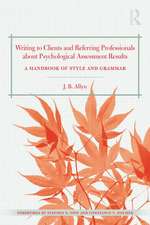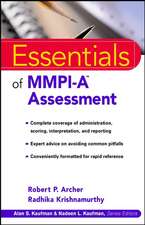Using Drawings in Clinical Practice: Enhancing Intake Interviews and Psychological Testing
Autor Gerald D. Osteren Limba Engleză Paperback – 17 feb 2016
| Toate formatele și edițiile | Preț | Express |
|---|---|---|
| Paperback (1) | 366.26 lei 6-8 săpt. | |
| Taylor & Francis – 17 feb 2016 | 366.26 lei 6-8 săpt. | |
| Hardback (1) | 1351.78 lei 6-8 săpt. | |
| Taylor & Francis – 4 feb 2016 | 1351.78 lei 6-8 săpt. |
Preț: 366.26 lei
Preț vechi: 385.54 lei
-5% Nou
Puncte Express: 549
Preț estimativ în valută:
70.12€ • 72.15$ • 59.10£
70.12€ • 72.15$ • 59.10£
Carte tipărită la comandă
Livrare economică 28 februarie-14 martie
Preluare comenzi: 021 569.72.76
Specificații
ISBN-13: 9781138024069
ISBN-10: 1138024066
Pagini: 202
Ilustrații: 59
Dimensiuni: 178 x 254 x 11 mm
Greutate: 0.36 kg
Ediția:1
Editura: Taylor & Francis
Colecția Routledge
Locul publicării:Oxford, United Kingdom
ISBN-10: 1138024066
Pagini: 202
Ilustrații: 59
Dimensiuni: 178 x 254 x 11 mm
Greutate: 0.36 kg
Ediția:1
Editura: Taylor & Francis
Colecția Routledge
Locul publicării:Oxford, United Kingdom
Public țintă
Professional and Professional Practice & DevelopmentCuprins
Chapter 1: DRAWINGS IN EVERYDAY PRACTICE
Case study – Sarah E.
Using drawings in clinical settings
Why use drawings?
Case study – Cheyenne R.
Drawings can be reassuring
Case study – Paul K.
Case study – Alice W.
Strengthening insight and problem solving
Disclosing temperament
Case study – Sam K.
Identifying goals and motivation
Talking through images
Vital points
Expansion of interpersonal engagement
Stimulating inspiration
Case study – Marcia T.
Concluding remarks
References
Chapter 2: FOUNDATIONS OF CLINICAL DRAWINGSHistorical aspects of clinical drawings
Images of psychological maturation
Developmental sequences
Cognitive maturation
Case study – Paul B.
Emotional indicators
Case study – James D.
Symbols of mental illness
Freud and Jung
Creative pursuits in psychotherapy
Case study – Elizabeth G.
Art therapy as a discipline
Interactions of art therapy and psychology
Case study – Lakandra F.
Case study – Charlotte P.
Controversies in drawing interpretation
From psychology to art therapy assessments
Silver drawing tests
Diagnostic drawing series
The person picking an apple from a tree
Enhancement to assessment
Cautionary tales
Concluding comments
References
Chapter 3: HOUSE-TREE-PERSON AND VARIATIONSHuman figures and everyday objects
House-Tree-Person
House drawings
Case study – Keli R.
Case study – Karl C.
The tree
Case study – Sakura R.
Case study – Sierra A.
Human figures
Case study – Joseph S.
Case study – Melissa B.
Case study – Monique W.
Kinetic house-tree-person
Case study – Mandy S.
Draw-a-person-in-the-rain
Case study – Toni N.
Family drawing procedures
Draw-a-family
Case study – Marla B.
Kinetic-family
Case study – Arlene G.
Family-centered-circle
Case study – Eddie C.
Mother-and-child
Case study – Alice W.
References
Chapter 4: ALTERNATIVE DRAWING DIRECTIVESBroadening the interpersonal encounter
Timelines
Case study – Lauren F.
Genograms
Case study – Nosian H.
Family shield
Case study – Albert J.
Draw your world
Case study – Amku L.
Draw yourself with friends
Kinetic school drawings
Case study – Kesandra B.
Draw your "ideal" self
Case study – Carla S.
Draw your (current) mood
Case study – Consuela L.
Defining and resolving problems
Case study – Alysha G.
Before, during, and after crises
Case study – Loren Y.
Ending remarks
References
Chapter 5: USING DRAWINGS DURING CLINICAL INTERVIEWSInformation gathering
Case study – Jacob D.
Conducting an initial interview
Case study – Lori S.
Behavioral observations
Case study – Eduardo L.
Case study - Randall M.
The crux of the interview
Types of clinical interviews
Intake interviews
Case study – Marilyn C.
Mental status exam
Case study – Breanna P.
Trauma interviews
CAPS
Case study – Kienna T.
Trauma symptom inventory
Case study – Nina F.
Trauma symptom checklist for children
Case study – Leyanna G.
Sexual abuse indicators in drawings
Case study – Louis T.
Benefits and limitations
Case study – Cheryl N.
Family evaluations
Sharing of conflicts
Case study – Jason A.
An enhancement to practitioners
References
Chapter 6: COMPREHENSIVE PSYCHOLOGICAL EVALUATIONS
Case study – Max T.
Case study – Janette B.
Psychological testing within the assessment process
Requests from treating professionals
Case study – Carlos B.
Responding to referral questions
Case study – Malcolm S.
Identifying presenting problems
The role of psychologists
Case study – Deborah M.
Case study - Charles L.
Puzzles that need solutions
Principles of psychological testing
Components of psychological evaluations
Selecting a test battery
Intellectual assessment
Academic achievement
Neuropsychological testing
Personality measures
Behavior rating scales
Projective techniques
Drawings in the test battery
Case study – Janice L.
Case study – John R.
The psychological report
Summaries of psychological evaluations
Marvin S.
Allison T.
Closing words
References
Case study – Sarah E.
Using drawings in clinical settings
Why use drawings?
Case study – Cheyenne R.
Drawings can be reassuring
Case study – Paul K.
Case study – Alice W.
Strengthening insight and problem solving
Disclosing temperament
Case study – Sam K.
Identifying goals and motivation
Talking through images
Vital points
Expansion of interpersonal engagement
Stimulating inspiration
Case study – Marcia T.
Concluding remarks
References
Chapter 2: FOUNDATIONS OF CLINICAL DRAWINGSHistorical aspects of clinical drawings
Images of psychological maturation
Developmental sequences
Cognitive maturation
Case study – Paul B.
Emotional indicators
Case study – James D.
Symbols of mental illness
Freud and Jung
Creative pursuits in psychotherapy
Case study – Elizabeth G.
Art therapy as a discipline
Interactions of art therapy and psychology
Case study – Lakandra F.
Case study – Charlotte P.
Controversies in drawing interpretation
From psychology to art therapy assessments
Silver drawing tests
Diagnostic drawing series
The person picking an apple from a tree
Enhancement to assessment
Cautionary tales
Concluding comments
References
Chapter 3: HOUSE-TREE-PERSON AND VARIATIONSHuman figures and everyday objects
House-Tree-Person
House drawings
Case study – Keli R.
Case study – Karl C.
The tree
Case study – Sakura R.
Case study – Sierra A.
Human figures
Case study – Joseph S.
Case study – Melissa B.
Case study – Monique W.
Kinetic house-tree-person
Case study – Mandy S.
Draw-a-person-in-the-rain
Case study – Toni N.
Family drawing procedures
Draw-a-family
Case study – Marla B.
Kinetic-family
Case study – Arlene G.
Family-centered-circle
Case study – Eddie C.
Mother-and-child
Case study – Alice W.
References
Chapter 4: ALTERNATIVE DRAWING DIRECTIVESBroadening the interpersonal encounter
Timelines
Case study – Lauren F.
Genograms
Case study – Nosian H.
Family shield
Case study – Albert J.
Draw your world
Case study – Amku L.
Draw yourself with friends
Kinetic school drawings
Case study – Kesandra B.
Draw your "ideal" self
Case study – Carla S.
Draw your (current) mood
Case study – Consuela L.
Defining and resolving problems
Case study – Alysha G.
Before, during, and after crises
Case study – Loren Y.
Ending remarks
References
Chapter 5: USING DRAWINGS DURING CLINICAL INTERVIEWSInformation gathering
Case study – Jacob D.
Conducting an initial interview
Case study – Lori S.
Behavioral observations
Case study – Eduardo L.
Case study - Randall M.
The crux of the interview
Types of clinical interviews
Intake interviews
Case study – Marilyn C.
Mental status exam
Case study – Breanna P.
Trauma interviews
CAPS
Case study – Kienna T.
Trauma symptom inventory
Case study – Nina F.
Trauma symptom checklist for children
Case study – Leyanna G.
Sexual abuse indicators in drawings
Case study – Louis T.
Benefits and limitations
Case study – Cheryl N.
Family evaluations
Sharing of conflicts
Case study – Jason A.
An enhancement to practitioners
References
Chapter 6: COMPREHENSIVE PSYCHOLOGICAL EVALUATIONS
Case study – Max T.
Case study – Janette B.
Psychological testing within the assessment process
Requests from treating professionals
Case study – Carlos B.
Responding to referral questions
Case study – Malcolm S.
Identifying presenting problems
The role of psychologists
Case study – Deborah M.
Case study - Charles L.
Puzzles that need solutions
Principles of psychological testing
Components of psychological evaluations
Selecting a test battery
Intellectual assessment
Academic achievement
Neuropsychological testing
Personality measures
Behavior rating scales
Projective techniques
Drawings in the test battery
Case study – Janice L.
Case study – John R.
The psychological report
Summaries of psychological evaluations
Marvin S.
Allison T.
Closing words
References
Notă biografică
Gerald D. Oster, PhD, has worked in a variety of inpatient and outpatient settings for more than 35 years. He is currently providing therapy and assessment services in private practice; he also supervises graduate students in psychological testing. In the past, he held the titles of clinical associate professor of psychiatry and psychology internship director. He has co-authored numerous books and professional publications, including Using Drawings in Assessment and Therapy: A Guide for Mental Health Professionals.
Recenzii
"Using Drawings in Clinical Practice is a gift to the field. Through a comprehensive approach describing the use of drawings as aids in the cognitive and emotional understanding of clients in mental health practice, Oster provides a valuable counterpoint to highly structured diagnostic and treatment systems that often are unable to provide an in depth understanding of clients' inner lives. This important book should be of value to a diverse group of mental health practitioners."
—Stewart Gabel, MD, former chair of the department of psychiatry and behavioral sciences at Children's Hospital Colorado
"Gerald Oster has written a comprehensive and expansive book that can be used as a teaching tool for mental health professionals and students. The case studies are personalized, pertinent, and thought provoking. The drawings tangibly display worries and concerns so they can be evaluated for the benefit of healthy therapeutic interventions. Throughout the book, Dr. Oster describes methods all mental health professionals can utilize in their everyday practice. From introduction to evaluation to closing, this book gives in-depth insight."
—Marcie Brooks, MA, LPCC, therapist in private practice and adjunct faculty at Southwestern College
"As a psychologist using drawings mainly with my PTSD/DID clients, I appreciate this book’s coverage of reasons to use art forms, case vignettes, historic background, and resources. Therapists of all experience levels will find Using Drawings in Clinical Practice useful; it has encouraged me to offer drawing to my adult clientele. Thank you, Dr. Oster!"
—Joan M. Offerle, PhD, Austin, Texas
"Gerald Oster has written a richly detailed and highly accessible guide to generating and making strategic use of images in assessment and therapy, regardless of one's theoretical orientation. This thoughtfully constructed text empowers clinicians to compassionately elicit drawings and verbal metaphors to support efficient rapport building, emotional expression, and perspective taking. Clients of all ages and diagnostic histories can benefit from these simple, brief approaches and the conversations that ensue. Plentiful case illustrations aid the reader's learning."
—Joshua Semiatin, PhD, clinical psychologist, Baltimore, Maryland
"Gerald Oster's Using Drawinsg in Clinical Practice... provides strong support for the use of these drawings when working with challenging clients, and he argues that projective drawings help in developing more accurate treatment recommendations for the client... Oster includes rich case examples and sample drawings to enhance his discussion of these tools... Oster provides numerous drawing tasts taht will be useful to clinicians looking to connect with clients and aid in gathering data to inform treatment."
--Meera Rastogi, University of Cincinnati, PsycCritiques
—Stewart Gabel, MD, former chair of the department of psychiatry and behavioral sciences at Children's Hospital Colorado
"Gerald Oster has written a comprehensive and expansive book that can be used as a teaching tool for mental health professionals and students. The case studies are personalized, pertinent, and thought provoking. The drawings tangibly display worries and concerns so they can be evaluated for the benefit of healthy therapeutic interventions. Throughout the book, Dr. Oster describes methods all mental health professionals can utilize in their everyday practice. From introduction to evaluation to closing, this book gives in-depth insight."
—Marcie Brooks, MA, LPCC, therapist in private practice and adjunct faculty at Southwestern College
"As a psychologist using drawings mainly with my PTSD/DID clients, I appreciate this book’s coverage of reasons to use art forms, case vignettes, historic background, and resources. Therapists of all experience levels will find Using Drawings in Clinical Practice useful; it has encouraged me to offer drawing to my adult clientele. Thank you, Dr. Oster!"
—Joan M. Offerle, PhD, Austin, Texas
"Gerald Oster has written a richly detailed and highly accessible guide to generating and making strategic use of images in assessment and therapy, regardless of one's theoretical orientation. This thoughtfully constructed text empowers clinicians to compassionately elicit drawings and verbal metaphors to support efficient rapport building, emotional expression, and perspective taking. Clients of all ages and diagnostic histories can benefit from these simple, brief approaches and the conversations that ensue. Plentiful case illustrations aid the reader's learning."
—Joshua Semiatin, PhD, clinical psychologist, Baltimore, Maryland
"Gerald Oster's Using Drawinsg in Clinical Practice... provides strong support for the use of these drawings when working with challenging clients, and he argues that projective drawings help in developing more accurate treatment recommendations for the client... Oster includes rich case examples and sample drawings to enhance his discussion of these tools... Oster provides numerous drawing tasts taht will be useful to clinicians looking to connect with clients and aid in gathering data to inform treatment."
--Meera Rastogi, University of Cincinnati, PsycCritiques
Descriere
Using Drawings in Clinical Practice covers everything mental-health professionals need to introduce drawings in treatment and to offer ways to facilitate meaningful communication and interactions in their practice settings.





















